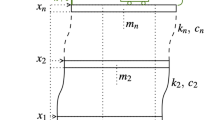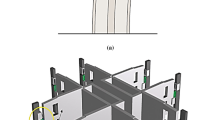Abstract
In this paper, we present a novel hybrid active and passive control method for very large floating structure (VLFS) to reduce the hydroelastic response, such that the resulting controlled VLFS can enhance its serviceability on the whole area. The floating beam structure is described as a distributed parameter system with partial differential equation (PDE). According to Lyapunov stability principle, a hybrid active and passive controller is designed to suppress the vibration of VLFS for the improvement in serviceability. In the active control design, two boundary controllers are developed to act on the upstream and downstream ends of VLFS, respectively. In passive control design, passive control components with high elastic rigidities are used to absorb the dynamic energy of VLFS from waves. Numerical simulations with comparison to the existing active control method are used to verify the effectiveness of the proposed control method. The parametric studies are given to examine the effects of various parameters to the vibration response of VLFS.








Similar content being viewed by others
References
He, W., Sun, C., Ge, S.S.: Top tension control of a flexible marine riser by using integral-barrier lyapunov function. IEEE/ASME Trans. Mechatron. 20(2), 497–505 (2015)
Kara, F.: Time domain prediction of hydroelasticity of floating bodies. Appl. Ocean Res. 51, 1–13 (2015)
Wang, C.M., Watanabe, E., Utsunomiya, T.: Very Large Float. Struct. Taylor & Francis, Abingdon (2008)
Wang, C.M., Tay, Z.Y., Takagi, K., Utsunomiya, T.: Literature review of methods for mitigating hydroelastic response of VLFS under wave action. Appl. Mech. Rev. 63, 1–18 (2010)
Watanabe, E., Utsunomiya, T., Wang, C.M.: Hydroelastic analysis of pontoon-type VLFS: a literature survey. Eng. Struct. 26, 245–256 (2004)
Khabakhpasheva, T.I., Korobkin, A.A.: Hydroelastic behaviour of compound floating plate in waves. J. Eng. Math. 44, 21–40 (2002)
Xia, D.W., Kim, J.W., Ertekin, R.C.: On the hydroelastic behavior of two dimensional articulated plates. Mar. Struct. 13(4–5), 261–278 (2000)
Syed, S.A., Mani, J.S.: Performance of rigidly interconnected multiple floating pontoons. J. Naval Archit. Mar. Eng. 1(1), 3–17 (2004)
Yu, L., Li, R., Shu, Z.: A numerical and experimental study on dynamic response of MOB connectors. In: Proceedings of the 14th International Offshore and Polar Engineering Conference. Toulon, France, pp. 636–643 (2004)
Karmakar, D., Bhattacharjee, J., Sahoo, T.: Wave interaction with multiple articulated floating elastic plates. J. Fluids Struct. 25(6), 1065–1078 (2009)
Fu, S.X., Moan, T., Chen, X.J., Cui, W.C.: Hydroelastic analysis of flexible floating interconnected structures. Ocean Eng. 34(11–12), 1516–1531 (2007)
Kim, B. W., Kyoung, J. H., Hong, S. Y., Cho, S. K.: Investigation of the effect of stiffness distribution and structure shape on hydroelastic response of very large floating structures. In: Proceedings of 15th International Offshore and Polar Engineering Conference. Seoul, South Korea, pp. 229-238 (2005)
Riyansyah, M., Wang, C.M., Choo, Y.S.: Connection design for two floating beam system for minimum hydroelastic response. Mar. Struct. 23(1), 67–87 (2010)
Gao, R.P., Wang, C.M., Koh, C.G.: Reducing hydroelastic response of pontoon-type very large floating structures using flexible connector and gill cells. Eng. Struct. 52, 372–383 (2013)
Yang, J.S., Gao, R.P.: Active control of a very large floating beam structure. J. Vib. Acoust. 138(2), 021010–021010-7 (2016)
He, W., He, X., Ge, S.S.: Vibration control of flexible marine riser systems with input saturation. IEEE/ASME Trans. Mechatron. 21(1), 254–265 (2016)
He, W., Ge, S.S.: Vibration control of a flexible beam with output constraint. IEEE Trans. Ind. Electron. 62(8), 5023–5030 (2015)
He, W., Zhang, S., Ge, S.S.: Robust adaptive control of a thruster assisted position mooring system. Automatica 50(7), 1843–1851 (2014)
He, W., Zhang, S., Ge, S.S.: Boundary output-feedback stabilization of a timoshenko beam using disturbance observer. IEEE Trans. Ind. Electron. 60(11), 5186–5194 (2013)
Pu, Z., Yuan, R., Yi, J., Tan, X.: A class of adaptive extended state observers for nonlinear disturbed systems. IEEE Trans. Ind. Electron. 62(9), 5858–5869 (2015)
Shang, Y.F., Xu, G.Q.: Stabilization of an Euler–Bernoulli beam with input delay in the boundary control. Syst. Control Lett. 61(11), 1069–1078 (2012)
Guo, B.Z., Yang, K.Y.: Dynamic stabilization of an Euler–Bernoulli beam equation with time delay in boundary observation. Automatica 45(6), 1468–1475 (2009)
Zhang, S., He, W., Nie, S., Liu, C.: Boundary control for flexible mechanical systems with input dead-zone. Nonlinear Dyn. 82, 1763–1774 (2015)
Acknowledgments
This research was supported in part by research project Grant (R-SMI-2013-MA-11) funded by the Singapore Maritime Institute.
Author information
Authors and Affiliations
Corresponding author
Appendices
Appendix 1
The kinetic energy \(E_\mathrm{k}\) in the VLFS system can be described as
where x and t represent the independent spatial and temporal variables, respectively. w(x, t) and \(\dot{w}(x,t)\) are the position and velocity on the position x of VLFS system at the time t.
The bending and tension potential energy \(E_\mathrm{p} \) in the VLFS system can be
where EI and T are the bending rigidity and tension of the VLFS system, respectively.
The virtual work done by ocean wave uncertainties on the VLFS is given by
where f(x, t) is the distributed load on the VLFS due to the hydrodynamic effects of the ocean waves.
The virtual work done by damping on the VLFS system is described by
where \(c_\mathrm{d} \) is the damping coefficient of the VLFS system.
The virtual work done by spring on the VLFS system is described by
where \(k_\mathrm{c} \) is the spring constant of the hydrostatic restoring force.
The virtual work done by the boundary control is written as
where u(L, t) is the control input at the position L of VLFS and v(0, t) is the control input at the position 0 of VLFS.
Thus, we have the total virtual work done on the VLFS as
Hamilton’s principle which is utilized to derive the governing equations of VLFS system is represented by
where \(t_1 \) and \(t_2 \) are two time instants with \(t_1<t<t_2 \) and \(\delta \) denotes the variational operator.
Then, we can obtain the governing equations of the system (1) with boundary conditions (1)–(3).
Appendix 2
Consider the system (1) and introduce the following appropriate integral Lyapunov functional candidates:
where
Define a new function as
Then, we have
Appling Lemma 1 to Eq. (20) yields
where \(s_1 =\alpha \rho L\).
Then, it can be obtained that
Combing Eqs. (20) and (22), we further obtain
with
where \(s_3 \) is a positive constant, and \(s_2 \) will be positive due to the appropriate choice of parameters \(\alpha \) and \(\beta \).
Given the proposed Lyapunov functional (16), it can be obtained
where \(s_4 =\min (s_2 ,1)\), \(s_5 =\max (s_3 ,1)\) are positive constants.
Differentiating Eq. (16) V(t) with respect to time t yields
where
Substituting boundary conditions (3) and (4) into \(\dot{V}_2 (t)\), we obtain
Substituting the system Eq. (1) into \(\dot{V}_3 (t)\) and using the boundary conditions (2)–(4), we obtain the derivative of \(V_3 (t)\) along VLFS system trajectory as
Substituting the proposed law (5) and (6) into Eq. (29) as well as combining Eqs. (28)–(30), we have
where \(K_\mathrm{D} \), g, r, \(\beta \), \(\sigma \), \(\alpha \), \(\delta _1 \), \(\delta _2 \), \(\delta _3 \), \(\delta _4 \) and \(\xi \) are chosen to satisfy the following inequalities:
Then, we have
where \(\varepsilon =\left( {\frac{\beta }{\sigma }+\mu _2 \gamma +\frac{\alpha L}{\delta _2 }} \right) \int _0^L {f^{2}(x,t)} \hbox {d}x\),\(\lambda _1 =\min (f_1 ,f_2 ,f_3 )\) and \(\lambda _2 =\min (\lambda _1 ,\frac{2\min (k,k_1 )}{T})\).
Furthermore, we have
where \(\lambda ={\lambda _2 }/{s_5 }>0\).
By integrating the inequality (40), we obtain
It indicates that V(t) is bounded. We have
Rearrangement of the term in the above inequality can yield
where w(x, t) is uniformly bounded.
Rights and permissions
About this article
Cite this article
Yang, J.S. Hybrid active and passive control of a very large floating beam structure. Nonlinear Dyn 87, 1835–1845 (2017). https://doi.org/10.1007/s11071-016-3156-8
Received:
Accepted:
Published:
Issue Date:
DOI: https://doi.org/10.1007/s11071-016-3156-8




